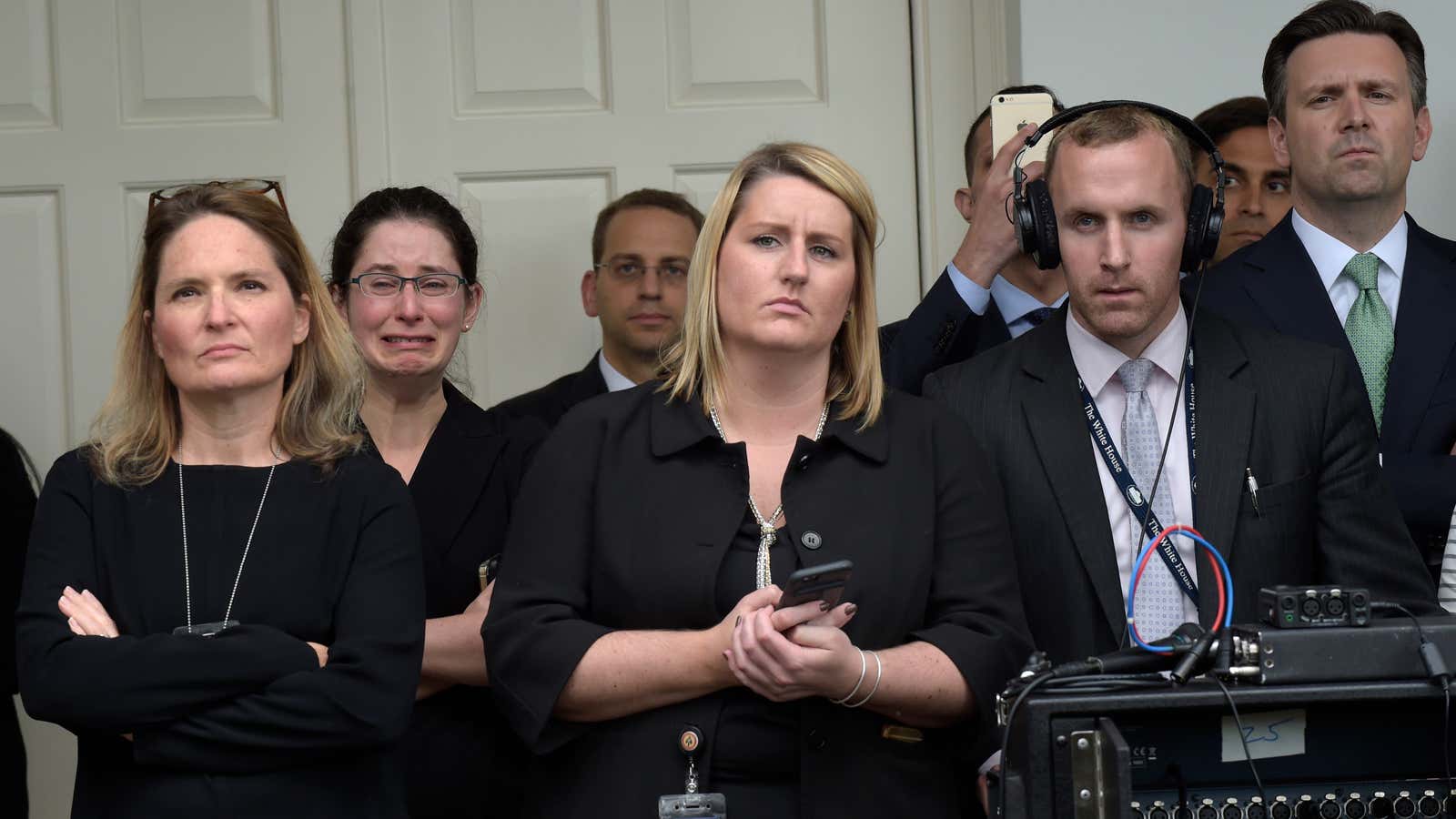During the fraught US presidential election of 2016, anxiety triggered by politics was a very real thing; therapists across the country were faced with patients’ nervous breakdowns. In the months after, post-election stress disorder plagued many. For many across the US, Donald Trump’s inauguration is dredging up new and discomfiting feelings. Psychology and sociology have a word for what’s going on: collective trauma.
Emotional trauma, broadly speaking, occurs when someone experiences an event as especially distressing—unexpected events, in particular, are likely to cause trauma. Later, when memories associated with that traumatic event are evoked, that person can experience feelings of injustice or physical symptoms of stress, says Charles Figley, chair of the disaster mental health program at Tulane University.
Collective trauma occurs when a traumatic memory is evoked for a group of people, and, for those who did not vote for Trump, the US presidential election has all the hallmarks of collective trauma: “There are a number of people who had assumed that Hillary Clinton would be elected; when she was not elected it really dumbfounded people and they really could not get their arms around it because they were so surprised,” says Figley. “Everyone was so shocked that it took a couple of weeks to process that. Now, there has been sufficient time for people of various factions to recognize the situation.”
Figley argues that the signs of collective trauma have been plentiful in recent months. “First and foremost it’s on everyone’s mind and it’s discussed frequently,” says Figley. “There are signs and symbols associated with it. Mentioning a particular slogan or singing a particular song simply connects people to the phenomenon and reminds everyone they are in the same boat.”
That trauma has deepened as the felt injustice has bled more and more into the public sphere. Ronald Eyerman, a professor of sociology at Yale University, says that trauma experienced at an individual level is transformed into collective trauma when the traumatic experience is turned into a community narrative. On election day, individuals who thought Clinton was going to win would have experienced the trauma of this loss, individually. But the telling of that story through journalism and art, this traumatic experience became communal. The protests and marches organized around the inauguration are another way in which trauma experienced individually is turned into a collective experience. “The protests and marches are a way in which a new collective identity is forged, and that experience of trauma becomes collective,” says Eyerman, who co-edited the book Narrating Trauma: On the Impact of Collective Suffering.
An unfortunate side effect of this sort of collective-identity formation, evident in the past few months, is racism and xenophobia. “People tend to separate from people that are different from them, connecting with people that are like them, and share their concerns, and vilify the opposition,” says Figley, adding that this is apparent the division in American society that has become palpable the past few months. People on the political left, who have suffered a traumatic loss, have reinforced their own bubble and disconnected with the opposition, in some cases disparaging Trump voters. Figley compares the dynamic to what he has seen in trauma management practice: When people are confronted with danger, they tend to cling tighter to those like them.
Eyerman compares the collective trauma experienced through the 2016 US presidential election and transition to that experienced by a society following the assassination of a leader with whom many in the community identify. “The experience of this election was not like losing a regular election,” says Eyerman, who posits that, for parts of the American electorate, it was akin to the experience of the assassinations of public figures like John F. Kennedy, Martin Luther King Jr., and Harvey Milk.
The real danger, though, is that the collective trauma will turn into cultural trauma, which can occur when the foundations of that collective identity are threatened, says Eyerman. Milk’s death is a good example. It started as a collective trauma when San Francisco—and the larger LGBT community—felt that Milk was murdered for political reasons, because he was gay. “His death was first collectively mourned in a massive march through the streets of San Francisco. This march was massive, but peaceful,” says Eyerman. A few months later, when his killer was convicted of voluntary manslaughter rather than murder, violent protests took place. While the peaceful protest was an expression of collective trauma, the violent protest betrayed a sense of cultural trauma.
“The verdict was interpreted by many in the collective, the San Francisco gay community, as a betrayal, a failure of American institutions, in this case the courts, the police and the justice system as a whole to do justice to an aggrieved group,” says Eyerman. “This betrayal and loss of faith in American institutions threatened the very foundations of collective identity.”
A similar thing could happen in 2017, Eyerman says, if new information surfaces that threatens the foundation of American institutions—if, for example, investigations into Donald Trump’s relationship with Russia reveal that the election was not conducted fairly or that the Russian government spent money to aid Trump’s electoral win, thus delegitimizing American democracy.
Even if that doesn’t happen, there’s still a lot of healing to be done. Communities heal from collective trauma in much the same way individuals deal with traumatic memories. “Initial shock, disbelief, and then an effort to try to explain that happened,” says Figley. “When a community collectively experiences a trauma, people ask each other questions about what happened and why it happened, who caused it whether it will happen again. Over a period of time there is an accommodation to loss, stock-taking, and gradual acceptance, and then creating new things in the wake of these changes that you didn’t want. People figure out what to do to feel safe again—physically or psychologically.”
